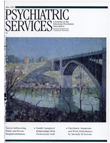Symptom severity and number of previous psychiatric admissions as predictors of readmission
Abstract
OBJECTIVE: The study examined factors predicting early readmission (within 30 days of discharge) to a state hospital. METHODS: A total of 189 patients with acute symptoms who were admitted to a state hospital were evaluated at discharge using the Brief Psychiatric Rating Scale (BPRS) and the Nurses Observation Scale for Inpatient Evaluation (NOSIE). Patients who were readmitted within 30 days were compared with those who were not on BPRS and NOSIE ratings and on other variables, including length of stay, number of previous admissions, demographic characteristics, and diagnosis. RESULTS: Scores on the thought disorder factor and self-neglect question on the BPRS and the number of previous admissions were significantly higher among patients who where readmitted within 30 days of discharge. The variables correctly predicted readmission for 86 percent of cases in the study. CONCLUSIONS: The characteristics of high scores at discharge on the BPRS thought disorder factor and the BPRS item on self-neglect, along with a high number of previous admission, may be helpful in identifying patients at risk for readmission to inpatient psychiatric settings.
Access content
To read the fulltext, please use one of the options below to sign in or purchase access.- Personal login
- Institutional Login
- Sign in via OpenAthens
- Register for access
-
Please login/register if you wish to pair your device and check access availability.
Not a subscriber?
PsychiatryOnline subscription options offer access to the DSM-5 library, books, journals, CME, and patient resources. This all-in-one virtual library provides psychiatrists and mental health professionals with key resources for diagnosis, treatment, research, and professional development.
Need more help? PsychiatryOnline Customer Service may be reached by emailing [email protected] or by calling 800-368-5777 (in the U.S.) or 703-907-7322 (outside the U.S.).



